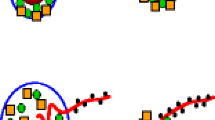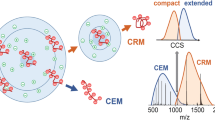Abstract
Electrospray ionization mass spectrometry (ESI-MS) experiments, including ion mobility spectrometry mass spectrometry (ESI-IMS-MS) and electron capture dissociation (ECD) of proteins ionized from aqueous solutions, have been used for the study of solution-like structures of intact proteins. By mixing aqueous proteins with denaturants online before ESI, the amount of protein unfolding can be precisely controlled and rapidly analyzed, permitting the characterization of protein folding intermediates in protein folding pathways. Herein, we mixed various pH solutions online with aqueous cytochrome C for unfolding and characterizing its unfolding intermediates with ESI-MS charge state distribution measurements, IMS, and ECD. The presence of folding intermediates and unfolded cytochrome c structures were detected from changes in charge states, arrival time distributions (ATDs), and ECD. We also compared structures from nondenaturing and denaturing solution mixtures measured under “gentle” (i.e., low energy) ion transmission conditions with structures measured under “harsh” (i.e., higher energy) transmission. This work confirms that when using “gentle” instrument conditions, the gas-phase cytochrome c ions reflect attributes of the various solution-phase structures. However, “harsh” conditions that maximize ion transmission produce extended structures that no longer correlate with changes in solution structure.
Graphical abstract






Similar content being viewed by others
References
Lossl P, van de Waterbeemd M, Heck AJ. The diverse and expanding role of mass spectrometry in structural and molecular biology. EMBO J. 2016;35(24):2634–57.
Hodge EA, Benhaim MA, Lee KK. Bridging protein structure, dynamics, and function using hydrogen/deuterium-exchange mass spectrometry. Protein Sci. 2020;29(4):843–55.
Sinz A, Arlt C, Chorev D, Sharon M. Chemical cross-linking and native mass spectrometry: a fruitful combination for structural biology. Protein Sci. 2015;24(8):1193–209.
Clemmer DE, Russell DH, Williams ER. Characterizing the conformationome: toward a structural understanding of the proteome. Acc Chem Res. 2017;50(3):556–60.
Dill KA, MacCallum JL. The protein-folding problem, 50 years on. Science. 2012;338(6110):1042–6.
Shen H-B, Chou K-C. QuatIdent: a web server for identifying protein quaternary structural attribute by fusing functional domain and sequential evolution information. J Prot Res. 2009;8(3):1577–84.
Chavez JD, Bruce JE. Chemical cross-linking with mass spectrometry: a tool for systems structural biology. Curr Opin Chem Biol. 2019;48:8–18.
Yee AA, Savchenko A, Ignachenko A, Lukin J, Xu X, Skarina T, et al. NMR and X-ray crystallography, complementary tools in structural proteomics of small proteins. J Am Chem Soc. 2005;127(47):16512–7.
Wells JN, Marsh JA. Experimental characterization of protein complex structure, dynamics, and assembly. In: Marsh JA, editor. Protein Complex Assembly: Methods and Protocols. New York, NY: Springer New York; 2018. p. 3–27.
Kaltashov IA, Eyles SJ. Studies of biomolecular conformations and conformational dynamics by mass spectrometry. Mass Spectrom Rev. 2002;21(1):37–71.
Smith DP, Giles K, Bateman RH, Radford SE, Ashcroft AE. Monitoring copopulated conformational states during protein folding events using electrospray ionization-ion mobility spectrometry-mass spectrometry. J Am Soc Mass Spectrom. 2007;18(12):2180–90.
Ow Y-LP, Green DR, Hao Z, Mak TW. Cytochrome c: functions beyond respiration. Nat Rev Mol Cell Biol. 2008;9(7):532–42.
Stevens JM, Mavridou DA, Hamer R, Kritsiligkou P, Goddard AD, Ferguson SJ. Cytochrome c biogenesis System I. FEBS J. 2011;278(22):4170–8.
Colón W, Elöve GA, Wakem LP, Sherman F, Roder H. Side chain packing of the N- and C-terminal helices plays a critical role in the kinetics of cytochrome c folding. Biochem. 1996;35(17):5538–49.
Englander SW, Sosnick TR, Mayne LC, Shtilerman M, Qi PX, Bai Y. Fast and slow folding in cytochrome c. Accounts of Chemical Research. 1998;31(11):737–44.
Travaglini-Allocatelli C, Gianni S, Brunori M. A common folding mechanism in the cytochrome c family. Trends Biochem Sci. 2004;29(10):535–41.
Roder H, Elove GA, Englander SW. Structural characterization of folding intermediates in cytochrome c by H-exchange labelling and proton NMR. Nature. 1988;335(6192):700–4.
Leney AC, Heck AJR. Native mass spectrometry: what is in the name? J Am Soc Mass Spectrom. 2017;28(1):5–13.
Zhang H, Cui W, Gross ML. Native electrospray ionization and electron-capture dissociation for comparison of protein structure in solution and the gas phase. Int J Mass Spectrom. 2013;354-355:https://doi.org/10.1016/j.ijms.2013.06.019.
Fenn LS, Kliman M, Mahsut A, Zhao SR, McLean JA. Characterizing ion mobility-mass spectrometry conformation space for the analysis of complex biological samples. Anal Bioanal Chem. 2009;394(1):235–44.
Zubarev RA, Kelleher NL, McLafferty FW. Electron capture dissociation of multiply charged protein cations. A nonergodic process. J Am Chem Soc. 1998;120(13):3265–6.
Breuker K, Oh H, Lin C, Carpenter BK, McLafferty FW. Nonergodic and conformational control of the electron capture dissociation of protein cations. Proc Natl Acad Sci USA. 2004;101(39):14011–6.
Wilson DJ, Konermann L. A capillary mixer with adjustable reaction chamber volume for millisecond time-resolved studies by electrospray mass spectrometry. Anal Chem. 2003;75(23):6408–14.
Zinck N, Stark AK, Wilson DJ, Sharon M. An improved rapid mixing device for time-resolved electrospray mass spectrometry measurements. Chemistryopen. 2014;3(3):109–14.
Liuni P, Deng B, Wilson DJ. Comparing equilibrium and kinetic protein unfolding using time-resolved electrospray-coupled ion mobility mass spectrometry. Analyst. 2015;140(20):6973–9.
Wyttenbach T, Bowers MT. Structural stability from solution to the gas phase: native solution structure of ubiquitin survives analysis in a solvent-free ion mobility-mass spectrometry environment. J Phys Chem B. 2011;115(42):12266–75.
Breuker K, Oh H, Horn DM, Cerda BA, McLafferty FW. Detailed unfolding and folding of gaseous ubiquitin ions characterized by electron capture dissociation. J Am Chem Soc. 2002;124(22):6407–20.
Skinner OS, McLafferty FW, Breuker K. How ubiquitin unfolds after transfer into the gas phase. J Am Soc Mass Spectrom. 2012;23(6):1011–4.
Ruotolo BT, Giles K, Campuzano I, Sandercock AM, Bateman RH, Robinson CV. Evidence for macromolecular protein rings in the absence of bulk water. Science. 2005;310(5754):1658–61.
Ruotolo BT, Robinson CV. Aspects of native proteins are retained in vacuum. Curr Opin Chem Biol. 2006;10(5):402–8.
Robinson CV, Chung EW, Kragelund BB, Knudsen J, Aplin RT, Poulsen FM, et al. Probing the nature of noncovalent interactions by mass spectrometry. A study of protein-CoA ligand binding and assembly. J Am Chem Soc. 1996;118(36):8646–53.
Seo J, Hoffmann W, Warnke S, Bowers MT, Pagel K, von Helden G. Retention of native protein structures in the absence of solvent: a coupled ion mobility and spectroscopic study. Angew Chem Int Ed. 2016;55(45):14173–6.
Merenbloom SI, Flick TG, Williams ER. How hot are your ions in TWAVE ion mobility spectrometry? J Am Soc Mass Spectrom. 2012;23(3):553–62.
Konermann L, Collings BA, Douglas DJ. Cytochrome c folding kinetics studied by time-resolved electrospray ionization mass spectrometry. Biochemistry. 1997;36(18):5554–9.
Konermann L, Pan J, Wilson DJ. Protein folding mechanisms studied by time-resolved electrospray mass spectrometry. Biotechniques. 2006;40(2):135–41.
Revercomb HE, Mason EA. Theory of plasma chromatography/gaseous electrophoresis. Review. Anal Chem. 1975;47(7):970–83.
Park J, Piehowski PD, Wilkins C, Zhou M, Mendoza J, Fujimoto GM, et al. Informed-proteomics: open-source software package for top-down proteomics. Nat Methods. 2017;14(9):909–14.
Fellers RT, Greer JB, Early BP, Yu X, LeDuc RD, Kelleher NL, et al. ProSight Lite: graphical software to analyze top-down mass spectrometry data. Proteomics. 2015;15(7):1235–8.
Kaltashov IA, Mohimen A. Estimates of protein surface areas in solution by electrospray ionization mass spectrometry. Anal Chem. 2005;77(16):5370–9.
Chen S-H, Russell DH. How closely related are conformations of protein ions sampled by IM-MS to native solution structures? J Am Soc Mass Spectrom. 2015;26(9):1433–43.
Konermann L, Metwally H, Duez Q, Peters I. Charging and supercharging of proteins for mass spectrometry: recent insights into the mechanisms of electrospray ionization. Analyst. 2019;144(21):6157–71.
Konermann L, Douglas DJ. Acid-induced unfolding of cytochrome c at different methanol concentrations: electrospray ionization mass spectrometry specifically monitors changes in the tertiary structure. Biochem. 1997;36(40):12296–302.
Goto Y, Hagihara Y, Hamada D, Hoshino M, Nishii I. Acid-induced unfolding and refolding transitions of cytochrome c: a three-state mechanism in water and deuterium oxide. Biochem. 1993;32(44):11878–85.
Rob T, Wilson DJ. A versatile microfluidic chip for millisecond time-scale kinetic studies by electrospray mass spectrometry. J Am Soc Mass Spectrom. 2009;20(1):124–30.
Winkler JR. Cytochrome c folding dynamics. Curr Opin Chem Biol. 2004;8(2):169–74.
Yin V, Konermann L. Probing the effects of heterogeneous oxidative modifications on the stability of cytochrome c in solution and in the gas phase. J Am Soc Mass Spectrom. 2021;32(1):73–83.
Borotto NB, Osho KE, Richards TK, Graham KA. Collision-induced unfolding of native-like protein ions within a trapped ion mobility spectrometry device. J Am Soc Mass Spectrom. 2022;33(1):83–9.
Fisher WR, Taniuchi H, Anfinsen CB. On the role of heme in the formation of the structure of cytochrome c. J Biol Chem. 1973;248(9):3188–95.
Xu Y, Mayne L, Englander SW. Evidence for an unfolding and refolding pathway in cytochrome c. Nat Struct Biol. 1998;5(9):774–8.
Bushnell GW, Louie GV, Brayer GD. High-resolution three-dimensional structure of horse heart cytochrome c. J Mol Biol. 1990;214(2):585–95.
Zhang Z, Vachet RW. Gas-phase protein salt bridge stabilities from collisional activation and electron transfer dissociation. Int J Mass Spectrom. 2017;420:51–6.
Molano-Arevalo JC, Jeanne Dit Fouque K, Pham K, Miksovska J, Ridgeway ME, Park MA, et al. Characterization of intramolecular interactions of cytochrome c using hydrogen-deuterium exchange-trapped ion mobility spectrometry-mass spectrometry and molecular dynamics. Anal Chem. 2017;89(17):8757–65.
Zhong Y, Han L, Ruotolo BT. Collisional and coulombic unfolding of gas-phase proteins: high correlation to their domain structures in solution. Angew Chem Int Ed Engl. 2014;53(35):9209–12.
Breuker K, McLafferty FW. Stepwise evolution of protein native structure with electrospray into the gas phase, 10(-12) to 10(2) s. Proc Natl Acad Sci U S A. 2008;105(47):18145–52.
Acknowledgements
The authors would like to acknowledge Professor Derek Wilson and his research group for helpful discussions.
Funding
Portions of this work were funded by the National Science Foundation CAREER CHE-2143755.
Author information
Authors and Affiliations
Corresponding author
Ethics declarations
Conflict of interest
The authors declare no competing interests.
Additional information
ABC Highlights: authored by Rising Stars and Top Experts.
Publisher’s note
Springer Nature remains neutral with regard to jurisdictional claims in published maps and institutional affiliations.
Supplementary Information
ESM 1
(PDF 517 kb)
Rights and permissions
Springer Nature or its licensor (e.g. a society or other partner) holds exclusive rights to this article under a publishing agreement with the author(s) or other rightsholder(s); author self-archiving of the accepted manuscript version of this article is solely governed by the terms of such publishing agreement and applicable law.
About this article
Cite this article
Cain, R.L., Webb, I.K. Online protein unfolding characterized by ion mobility electron capture dissociation mass spectrometry: cytochrome C from neutral and acidic solutions. Anal Bioanal Chem 415, 749–758 (2023). https://doi.org/10.1007/s00216-022-04501-w
Received:
Revised:
Accepted:
Published:
Issue Date:
DOI: https://doi.org/10.1007/s00216-022-04501-w




